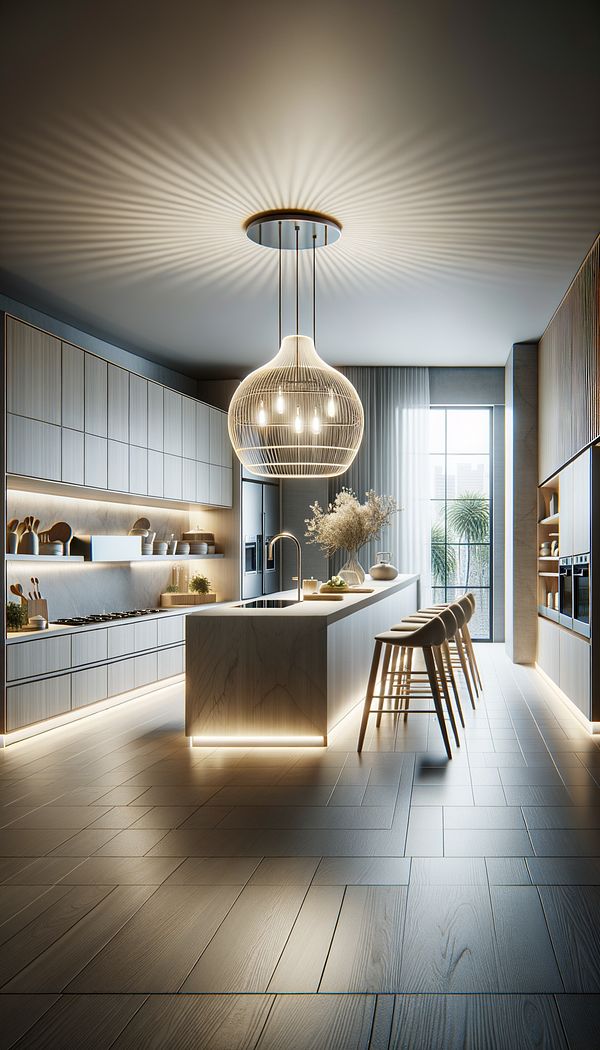What is Pendant?
A pendant is a light fixture that hangs from the ceiling via a cord, chain, or metal rod.
Description
In interior design, pendants are not only functional sources of lighting but also serve as decorative elements that can enhance the aesthetic of a room. They are suspended from the ceiling by a cord, chain, or metal rod, often allowing their height to be adjusted as per need. Pendants come in a multitude of styles, sizes, and materials, making them versatile for use in various design schemes, from modern to traditional.
Pendants can be used singly to highlight a specific area, such as over a kitchen island or dining table, or in multiples to create even illumination throughout a space. Their designs can range from simple and sleek to intricate and ornate, with options available to suit every taste and budget. When choosing a pendant, it's important to consider the scale of the fixture in relation to the room size and ceiling height, as well as the amount of light it emits. Using pendants in combination with other lighting sources, like recessed lighting, floor lamps, and table lamps, can help achieve a balanced and layered lighting scheme.
For spaces that require task lighting, such as kitchens and home offices, pendant lights that focus light downwards can be particularly effective. Conversely, for areas where ambiance is key, choosing pendants that cast a soft, diffuse light can create a warm and inviting atmosphere.
Usage
Pendant lights are commonly found hanging above kitchen islands in modern homes, providing focused task lighting while also serving as a decorative element. In living rooms, bedrooms, and dining areas, pendants are often used to add a stylistic touch and to enhance the overall design theme of the space. High-ceilinged entranceways and foyers may feature large, statement-making pendant fixtures that draw the eye upwards and create a dramatic first impression.
FAQs
-
Can pendant lights be adjusted in height?
Yes, most pendant lights can be adjusted in height during installation to fit the specific needs of a space. This is usually achieved by shortening the cord, chain, or metal rod from which the pendant hangs.
-
Are pendant lights suitable for every room in a house?
Pendant lights can be adapted to nearly every room, depending on the function of the space and the style of the pendant. Careful consideration of the fixture's size and the amount of light it provides will help determine its suitability.
-
How do you choose the right size pendant for a space?
To choose the right size pendant, consider the scale of the fixture in relation to the room's size and ceiling height. A common rule of thumb is to measure the room in feet, then add those numbers together and convert the total to inches to get an appropriate diameter for the pendant.
Practical Application
When incorporating pendants into your design, consider the mood and functionality you wish to achieve. For task-oriented areas, opt for pendants that provide direct, focused light. For ambient lighting, select those with diffuser panels or shades that cast a softer glow. It's also crucial to balance the pendant's size and design with the room's scale and decor. Experimenting with different bulb types can alter the light quality a pendant emits, further tailoring the atmosphere of the space.
-
Palladian WindowA Palladian Window is a large window that is divided into three parts, with a semicircular arch over the central section.
-
Asian Zen StyleAsian Zen Style is a tranquil and minimalist interior design approach influenced by the simplicity and natural elements of Zen philosophy.
-
Color SchemeA color scheme is an intentional selection of colors used in design for aesthetics and practical purposes.
-
HierarchyHierarchy in interior design refers to the deliberate organization of elements in a space to signify their importance.
-
LampA lamp is a device that produces light, usually for interior spaces.
